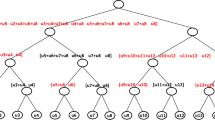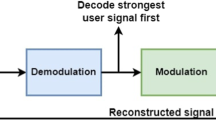Abstract
A pipelined Fast Fourier Transform and its inverse (FFT/IFFT) processor, which utilizes hardware resources efficiently, is proposed for MIMO-OFDM WLAN 802.11n. Compared with a conventional MIMO-OFDM implementation, (in which as many FFT/IFFT processors as the number of transmit/receive antennas is used), the proposed architecture (using hardware sharing among multiple data sequences) reduces hardware complexity without sacrificing system throughput. Further, the proposed architecture can support 1–4 input data sequences with sequence lengths of 64 or 128, as needed. The FFT/IFFT processor is synthesized using TSMC 0.18 um CMOS technology and saves 25% area compared to a conventional implementation approach using radix-23 algorithm. The proposed FFT/IFFT processor can be configured to improve power efficiency according to the number of input data sequences and the sequence length. The processor consumes 38 mW at 75 MHz for one input sequence with 64-point length; it consumes 87 mW at 75 MHz for four input sequences with length 128-point and can be efficiently used for IEEE 802.11n WLAN standard.











Similar content being viewed by others
References
Weste, N., & Skellem, D. J. (1998). VLSI for OFDM. IEEE Communications Magazine, 36(10), 127–131 Oct.
Stuber, G. L., et al. (2004). Broadband MIMO-OFDM wireless communications. Proceedings of the IEEE, 92(2), 271–294 Feb.
Coffey, S. et al. (2005). Joint proposal: high throughput extension to the 802.11 standard: PHY. Nov., IEEE 802.11–05/1102r0.
Petrus, P. et al. (2007). An integrated draft 802.11n compliant MIMO baseband and MAC processor. In Proc. of ISSCC’07, pp. 266–268, Feb.
Schwoerer, L., Bui, T., & Zielinski, E. (2006). Multi-size Multi-stream FFT. In Proc. of Wireless and Optical Communications 2006, 119–123.
Lin, H. L. et al. (2006). A high speed highly pipelined 2n-point FFT architecture for a dual OFDM processor. In Proc. Intl. Conf. Mixed Design of Integrated Circuits and Systems, 627–631.
Sansaloni, T., Pérez-Pascual, A., Torres, V., & Valls, J. (2005). Efficient pipeline FFT processors for WLAN MIMO-OFDM systems. Electronic Letters, 41(19), 1043–1044 Sep.
Lin, Y. W., & Lee, C. Y. (2007). Design of an FFT/IFFT processor for MIMO OFDM systems. IEEE Transactions on Circuits and Systems I, 54, 807–815 Apr.
Bass, B. B. (1999). A low-Power, high-performance, 1024-point FFT processor. IEEE Journal of Solid-State Circuits, 34(3), 380–387 Mar.
He, S., & Torkelson, M. (1998). Designing pipeline FFT processor for OFDM (de)modulation. In Proc. IEEE URSI Int. Symp. Sig. Syst. Electron., 257–262.
Zhang, N., Zhang, X., & Zhang, C. (1990). Two kinds of array architecture for FFT processor. In Proc. Int. Conf. Signal Processing, 1161–1162.
Hasan, M., & Arslan, T. (2002). Scheme for reducing size of coefficient memory in FFT processor. IEE Electronic Letters, 38, 163–164.
Jung, Y., Yoon, H., & Kim, J. (2003). New efficient FFT algorithm and pipeline implementation results for OFDM/DMT applications. IEEE Transactions on Consumer Electronics, 49(1), 14–20.
Lin, Y. W., Liu, H., & Lee, C. (2005). A 1-GS/s FFT/IFFT processor for UWB applications. IEEE Journal of Solid-State Circuits, 40(8), 1726–1735.
Rabiner, L. R., & Gold, B. (1975). Theory and application of digital signal processing. Prentice-Hall, Inc.: New Jersey.
Abu-Khater, I. S., Yan, R. H., Bellaouar, A., & Elmasry, M. I. (1996). Circuit techniques for CMOS low-power high-performance multipliers. IEEE Journal of Solid-State Circuits, 31(10), 1535–1546 Oct.
Jia, L., Gao, Y., Isoaho, J., & Tenhunen, H. (1998). A new VLSI-oriented FFT algorithm and implement. In Proc. 11th Annu. IEEE Int. ASIC Conf., pp. 337–341, Sep.
Maharatna, K., Grass, E., & Jagdhold, U. (2004). A 64-point Fourier transform chip for high-speed wireless LAN application using OFDM. IEEE Journal of Solid-State Circuits, 39, 484–493.
Lin, C. T., Yu, Y. C., & Van, L. D. (2006). A low power 64-point FFT/IFFT design for IEEE 802.11a WLAN application. In Proc. of ISCAS’06, pp. 4523–4526.
Zhang, G., & Chen, F. (2004). Parallel FFT with CORDIC for ultra wide band. In Proc. of 15th IEEE International Symposium on Personal, Indoor and Mobile Radio Communications, pp. 1173–1177, Sep.
Huggett, C., Maharatna, K., & Paul, K. (2005). On the implementation of 128-pt FFT/IFFT for high-performance WPAN. In Proc. of ISCAS’05, pp. 5513–5516.
Author information
Authors and Affiliations
Corresponding author
Rights and permissions
About this article
Cite this article
Fu, B., Ampadu, P. An Area Efficient FFT/IFFT Processor for MIMO-OFDM WLAN 802.11n. J Sign Process Syst Sign Image Video Technol 56, 59–68 (2009). https://doi.org/10.1007/s11265-008-0264-9
Received:
Revised:
Accepted:
Published:
Issue Date:
DOI: https://doi.org/10.1007/s11265-008-0264-9




